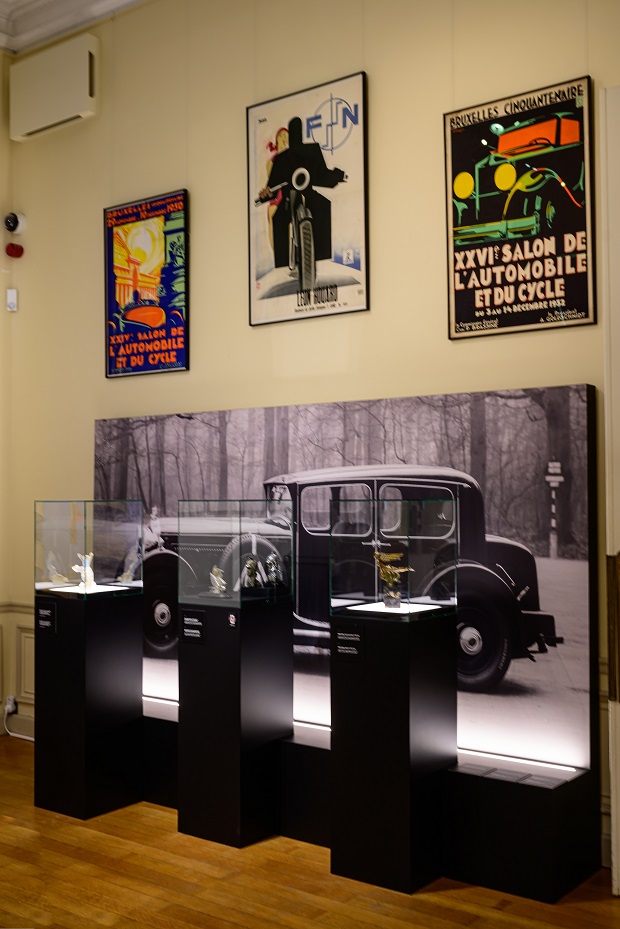- Daily & Weekly newsletters
- Buy & download The Bulletin
- Comment on our articles
‘Art Deco. Style in a changing society’: Exceptional artworks dazzle in free exhibition at BELvue Museum
Among the slew of exhibitions marking the centenary of Art Deco in Brussels in 2025, BELvue Museum presents stunning works by predominantly Belgian artists that evoke a golden age of creativity in the interwar years.
Art Deco. Style in a changing society not only shines a light on the movement’s shimmering modernism, it delves into the social upheaval, progression and democratisation of art that underpinned the new bold aesthetic.
An initiative of the King Baudouin Foundation (KBF), more than 150 artworks from the philanthropy institution’s collections capture the innovation and evolution of this fascinating period. Encompassing sculpture, ceramics, glassware, posters, books and automobile memorabilia, the free exhibition serves as an introduction to the capital’s other centenary activities, according to curators Dr Werner Adriaenssens and Cécile Dubois.

In selecting works from the foundation’s extensive collections, the Art Deco experts focused on conveying the principal characteristics of the new vibrantly-coloured movement and placing it in the context of a rapidly-changing society, explains Adriaenssens. If Art Nouveau was the domain of the rich, Art Deco diffused to the middle classes thanks to an economic drive to commercialise decorative art.
The movement officially debuted in 1925 at Paris’s month-long International Exhibition of Modern Decorative and Industrial Arts, which was graced by a Belgian pavilion designed by Victor Horta. The Art Nouveau pioneer now resolutely turned his talents to the burgeoning style after an inspiring sojourn in the US.

Influenced by Art Nouveau, Cubism and the Bauhaus, Art Deco was in many ways a natural response to the seismic shift in society provoked by World War One. It encapsulated the opulence and escapism of the age with its sleek lines, geometric shapes and exotic motifs, while also reflecting the fascination for speed, machines and modern technology.
The movement’s impact on society is explored in three themed rooms dedicated to luxury, mass production and modernity. The scenography features large-format photographs of Art Deco public buildings to provide stylistic context and atmosphere. The connecting corridor contains panels exploring societal issues with a contemporary flavour.

In the first space, visitors discover masterpiece works of art that were created for the upper echelons of society. A series of exquisite sculptures by leading artists of the age include Oscar Jespers’ early 1920s Perle fine (pictured), an ethereal portrait in marble of a female head that is one of the earliest Belgian masterpieces of modernism. Marcel Wolfers’ 1931 ivory piece Victoire à la Couronne de Laurier is another example of refined artistry and powerful female representation.
The increasing emancipation of women following their inroads into the workforce during the war. “Skirts shortened and women stopped wearing corsets,” says Dubois, while pointing out that this and other freedoms largely concerned younger women.

Belgian craftsmanship was enjoying its heyday at the beginning of the 20th century. The Val--Saint-Lambert glassworks in Liège exported exclusive crystalware around the world and produced innovative Art Deco collections. Its Cardinal vase (pictured) combined technical prowess with stylistic originality; contrasting black and gold hues evoking sophistication and glamour.
New religious buildings sprung up during the interwar period, including Brussels’ Koekelberg Basilica. A striking chalice fashioned by Brussels goldsmith Wolfers’ Frères was designed in 1931 by the Benedictine monk Dom Martin for the archbishop Jean Jadot. Exceptionally, it boasts a tiger’s eye gemstone.

The second room illustrates the increasing mass production of artworks, furniture and decorative objects. Art Deco was becoming a global movement with the aesthetic finding its way into the homes of the burgeoning middle classes. A display of ceramic tiles vividly presents the diversity in styles that adorned kitchens and bathrooms, including geometric shapes and overblown fruits in a new emerging colour palette.
In addition to luminous glassware by Val-Saint-Lambert, there are colourful and detailed ceramics by Charles Catteau, the Franco-Belgian designer who headed the Boch Frère Keramis workshops in La Louvière. A variety of motifs were employed in decorating vases, including exotic vegetation and wild animals that reflected Belgian colonisation in Africa. Under his influence, Belgium’s largest producer of ceramicware achieved unrivalled success. It was Catteau’s 'art for all' philosophy that enabled original and quality designs to be manufactured on an industrial scale. Vases can still be picked up quite cheaply in flea markets in the region and found in the homes of families connected to the factory.

Finally, the exhibition explores social progress and mobility. Heralding the section is a large colourful poster promoting the automobile industry by former Belgian motor manufacturers Minerva and FN (better know today for its arms production). The Roaring Twenties were a time of speed and Belgium boasted flourishing automobile associations. Among the wealth of objects in the KBF collections, the curators selected an assortment of futuristic radiator caps displayed in front of a large photo of a luxury car parading in the Bois de La Cambre.
Meanwhile, the introduction of paid leave during the 1930s led to the emergence of leisure and sports disciplines. Outdoor swimming pools were all the rage and their architectural Art Deco ocean liner designs contributed to the enduring appeal of the aesthetic. Book binding also received a makeover with stylistic flourishes adorning leather-bound albums.

With the advent of large-scale manufacturing, fashionable department stores proposed themed interiors complete with furniture, accessories and decorative objects. A commonplace concept today, it was novel at the time and contributed to the popularity of Art Deco.
For Adriaenssens, the style was also successful because of its classicism. “Art Nouveau was more about museum pieces, while Art Deco was something you could have in your house; the forms were simpler and easier to mix with other styles.”
The exhibition is part of Brussels’ year-long celebration Art Deco Brussels 2025. Guided tours, talks by the curators and workshops are staged at the museum for its duration.
Art Deco. Style in a changing society
Until 4 January
BELvue Museum
Place des Palais 7
Brussels
Photos: BELvue Museum©Jo Exelmans


















